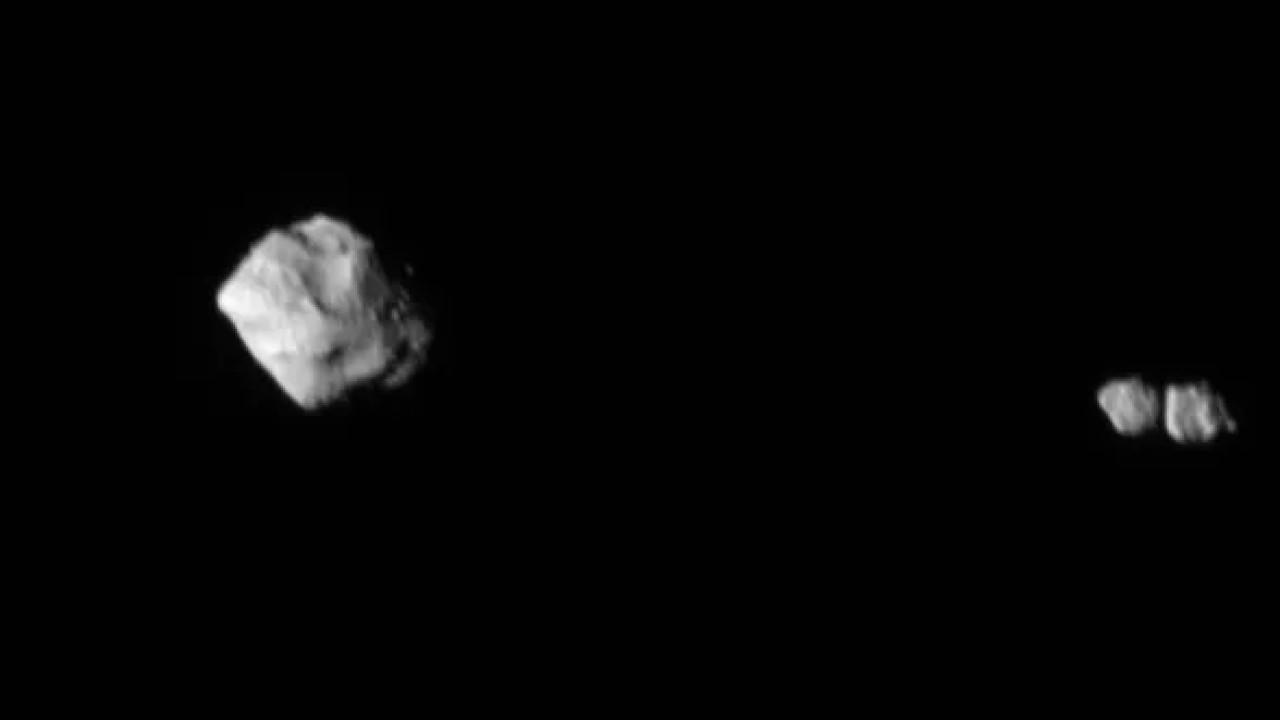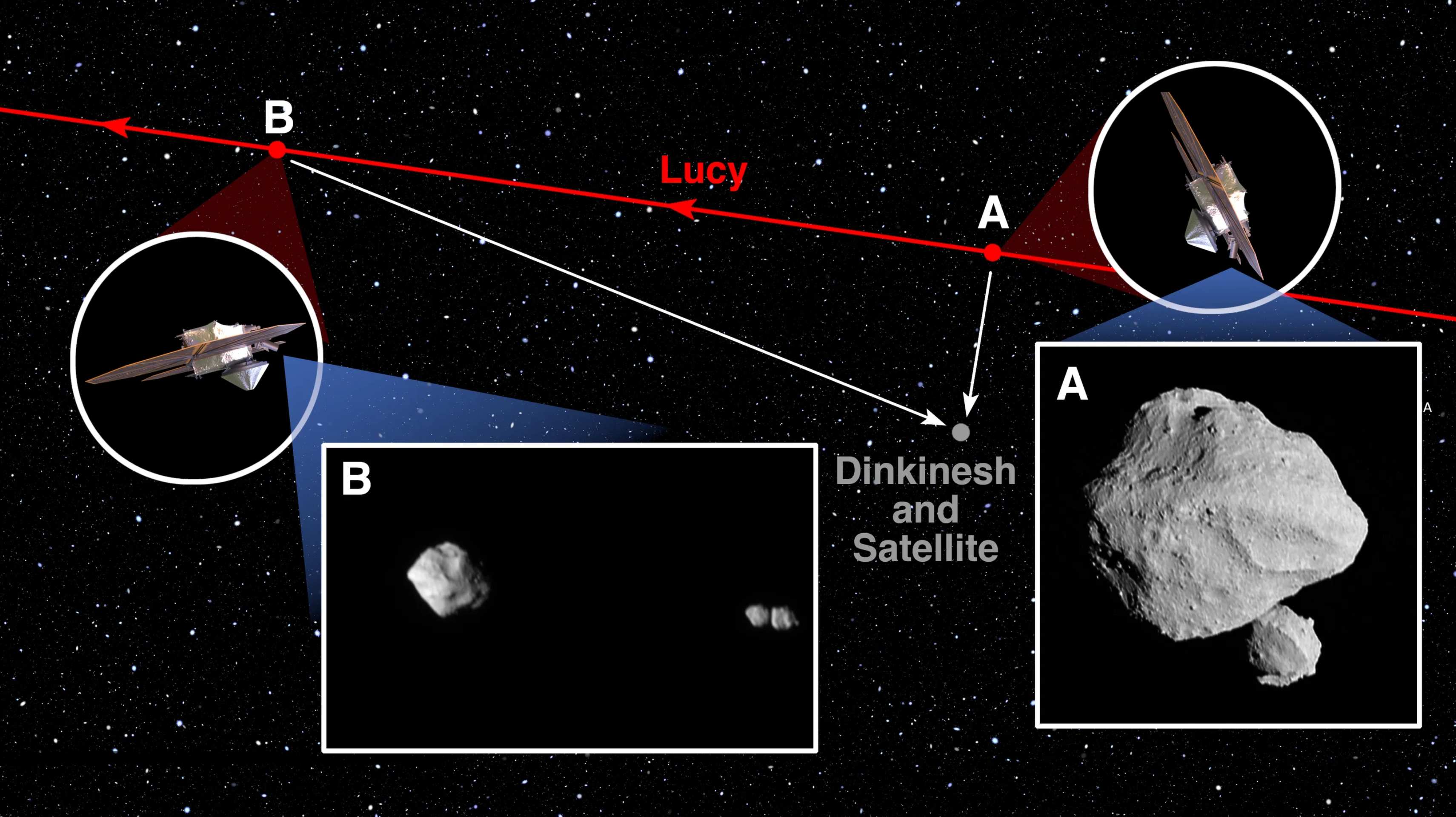Asteroid 'Dinky,' visited by NASA's Lucy spacecraft, birthed its own moon
The small moon, which is the first contact-binary satellite found orbiting an asteroid, was spun off its parent space rock.

Scientists may have learned the history of the tiny contact-binary moon orbiting asteroid 152830 Dinkinesh, which was the first cosmic stop for NASA's Lucy spacecraft. That moonlet may have spun off its larger parent asteroid when Dinkinesh was sent twirling through space after absorbing and re-emitting sunlight.
Having launched in 2021, the Lucy mission is on its way to explore the Trojan asteroids, which share the orbit of Jupiter — but, to reach them, Lucy has to cruise through the asteroid belt between Mars and Jupiter. In a silver lining, however, this has given Lucy the chance to test its prowess on a minor world in the asteroid belt before reaching the Trojans, which are positioned at Jupiter's L4 and L5 Lagrange points.
Related: Lucy mission: NASA's journey to the Trojan asteroids
On Nov. 1, 2023, Lucy flew within 268 miles (431 kilometers) of Dinkinesh, which is affectionately nicknamed 'Dinky.' That might not sound like a notable distance until you consider that Dinkinesh is just 787 yards (720 meters) in diameter. Yet, the spacecraft's autonomous range-finding and tracking system was able to lock onto Dinkinesh, allowing the Lucy Long-Range Reconnaissance Imager (L'LORRI) to image the asteroid.
What it found was surprising: Dinkinesh is not alone!
L'LORRI discovered a natural satellite orbiting Dinky every 52.7 hours at a distance of 1.9 miles (3.1 kilometers). For an asteroid to have a moon isn't that surprising; astronomers are discovering that about 15% of small asteroids indeed have companions, such as Dimorphos, which is the small body that orbits the asteroid Didymos and which was subject to NASA's DART planetary defense mission in 2022. What is particularly interesting about Dinky, however, is that its little moon, called Selam, is itself a contact binary — two objects stuck together as one.
Again, contact binaries in and of themselves are not that rare; the comet 67P/Churyumov–Gerasimenko, for instance, visited by the European Space Agency's Rosetta mission for two years between 2014 and 2016, was a contact binary. Arrokoth, which is the Kuiper Belt object that New Horizons flew past on New Year's Day 2019, is also a contact binary.
Get the Space.com Newsletter
Breaking space news, the latest updates on rocket launches, skywatching events and more!
However, Selam is the first contact-binary-asteroid-moon situation.
More specifically, Selam appears to be two objects, or lobes, touching end to end. They are similarly sized: one lobe is about 230 yards (210 meters) across and the other is 250 yards (230 meters) across. Selam is tidally locked to Dinkinesh, meaning one lobe permanently remains closest to the larger asteroid. Frustratingly, the contact point between the two lobes is hidden in shadow in L'LORRI's images.

Naturally, astronomers sought to learn how Selam had formed like this. The clues, according to a team led by the mission's principal investigator, Hal Levison of the South-west Research Institute in Boulder, Colorado, can be found on the surface of Dinkinesh.
The larger asteroid is distinguished by a large trough that runs longitudinally around it, as well as an equatorial ridge that is overlaid on top of that trough and wraps around its rotational axis. Levison's team argues that these features are the result of a massive structural calamity that occurred when the asteroid's rotation was spun up by a phenomenon called the YORP effect.
Short for Yarkovsky–O'Keefe–Radzievskii–Paddack, after the scientists who first modeled it, the YORP effect describes how a modestly small object such as Dinkinesh can be spun up by the effects of absorbing and then re-emitting sunlight. The momentum of solar photons striking the surface, and then thermal photons emitted from the surface as the surface warms in the sunlight, create small amounts of thrust that can push around an asteroid smaller than about 3.1 miles (5 kilometers) wide. Though such thrust would be extremely gentle, over eons, it would be able to build up enough power to greatly affect an asteroid's rotation. In terms of Dinkinesh, the YORP effect led to an increase in the space rock's rotation — today, it spins once every 3.7 hours.
But that wasn't all.
The resulting centrifugal force on Dinkinesh, scientists have now learned, then caused some material to lift off the surface of the spinning, loosely held together, asteroid. That material then settled into a ring of debris around the asteroid's equator. Structurally destabilized, a crack literally appeared on Dinkinesh's surface — the large trough that we see today.
Some of the material spun off from Dinkinesh fell back onto the asteroid, forming the equatorial ridge, while the rest coalesced to form two satellites. This, by the way, is the mechanism believed to have formed Didymos' moon Dimorphos, too.
Dimorphos, however, is just one ordinary satellite — so, to create a contact binary such as Selam there must be more to the story.
Levison is intrigued by the fact that the two lobes are almost identical in size, and wonders whether this is telling us something about the satellite formation process. Regardless, once the two halves of Selam formed, they must have edged closer and closer together, moving at very low relative velocity, until they were close enough to kiss. From there, gravity was able to hold them together.
Nature, it seems, had performed a most delicate operation when creating Selam.
Had these lobes touched with a higher relative velocity, they would have either become smushed together to form just a single lobe, or, more likely, smashed each other apart. Instead they bonded, and are now literally stuck with one another.
The analysis of Lucy's observations of Dinkinesh and Selam are published in Nature.
Join our Space Forums to keep talking space on the latest missions, night sky and more! And if you have a news tip, correction or comment, let us know at: community@space.com.

Keith Cooper is a freelance science journalist and editor in the United Kingdom, and has a degree in physics and astrophysics from the University of Manchester. He's the author of "The Contact Paradox: Challenging Our Assumptions in the Search for Extraterrestrial Intelligence" (Bloomsbury Sigma, 2020) and has written articles on astronomy, space, physics and astrobiology for a multitude of magazines and websites.









